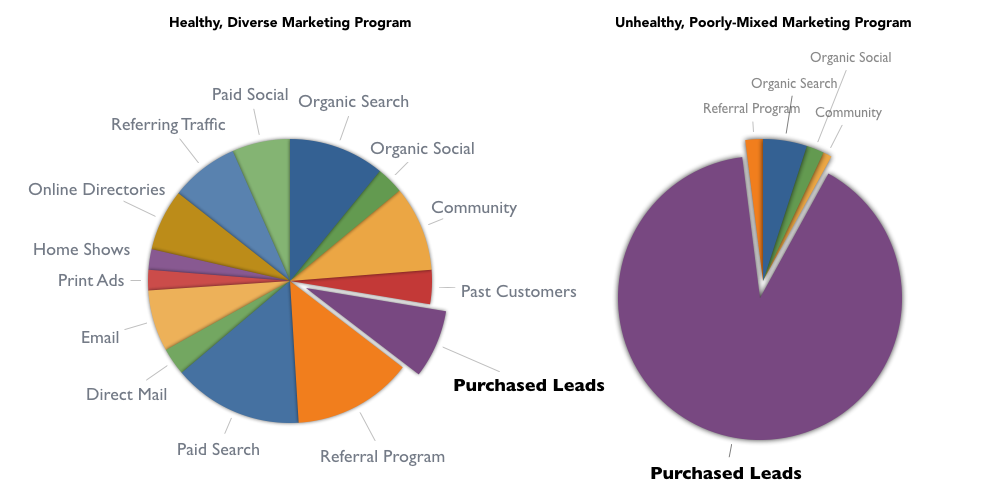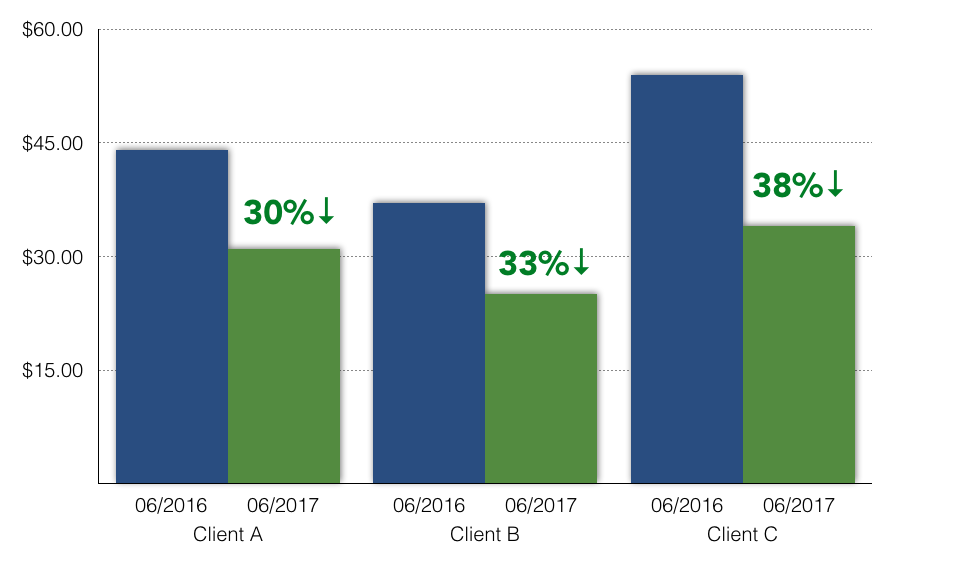
A solar version of this is posted on Solar Power World. Interested in learning how you can reduce your dependence on buying leads through Search Engine Marketing (SEM)? Click here to download the Solar SEM Guide, where we share our lessons learned spending $250k on solar SEM campaigns.
For many contracting businesses, purchased leads — from lead brokers, franchises, lead-only marketing firms, Google, HomeAdvisor — are the way of the world. This is especially rampant in solar, where an entire breed of lead sourcing companies dominates the top of the funnel, and this approach is becoming prominent in HVAC and home performance as well.
Being overly reliant on purchased leads is a bit like the path to alcoholism: one or two glasses of red wine each night is good for your heart, but when it starts to be bourbon in your OJ each morning it ultimately leads to dependency, a failing liver, and death.
The lure of outsourcing your lead generation is understandable. Companies that offer these services promise “no risk,” “no money upfront,” “100% performance based.” If your business can rely on a third-party to provide a steady flow of leads at a cost that pencils (more on that math in a bit), then everything should be hunky dory, right?
Wrong. Here’s why:
Dependency
Choose your analogy — alcohol, drugs, health — but when you outsource the majority of your lead generation to a third-party you are setting your company up for a very unhealthy and risky addiction. Leads are clearly the lifeblood of any contracting business. In today’s marketing world, the reality is that your leads will typically come from a wide variety of sources.
For healthy contracting businesses, the lead mix is diverse and no one or two channels dominate. A typical Energy Circle client in 2016 would have 15-20 different sources of leads, no one of which represents more than 20% of overall lead volume. This variety can certainly be intimidating (keeping an eye on 20 lead channels — yikes!) but it is also healthy, similar to diversity in an investment portfolio. With the digital world changing so frequently, and the possibility of a single flip of the switch at Google causing an entire channel to dry up overnight, lead mixes that are overly dependent on one source are high risk. We see many companies reliant on purchased leads to have all or most of their eggs in one basket.
Your Lead Mix: Healthy and Diverse or Too Dependent on Purchased Leads?

Healthy, well-managed contractors with mature marketing programs have a diverse mix of lead sources and minimal dependence on any one channel.
The other side of outsourcing your leads is that you are ultimately dependent on some third-party for a fundamental driver of your revenue. That can work, but what happens when the quality of leads from that source declines? Or when they jack up the price of purchased leads?
Whose Leads are You Paying For?
In models where you hand over control of your website to a third-party lead generator, there is inevitable conflict over who gets credit for leads. If someone saw your truck, remembered your company, found your website and called for a quote, is that a lead you should be charged $100 for? Should a past customer that just happened to be reminded about your latest promotion via a Facebook ad be a lead you should pay for? Good companies are fair about this. With Google Home Services Ads (a test product currently in select CA markets), for example, an out of area lead requires a phone call to Google to resolve. The Google reps are apparently great about it--no questions asked--but someone does have to make that call. Inevitably, this sets up relationship conflict at the center of your marketing. When you receive leads with no transparency on where or how they were generated, how do you know?
Do You Own Your Company Assets?
In today’s marketing world, your company’s place on the web — your website primarily but also your presence in social media and directories — is the funnel through which virtually all of your leads flow. Very often, companies that rely too much on purchased leads also outsource their web presence. Marketing companies insist on building a second or third website so they can track leads separately. A new breed of marketing firms build you a website for free in exchange for a commitment to buy leads, but you don’t own or fully control your own site. If you ever need to separate from that firm, you’ll often face costly technical challenges to transfer your site content, and sometimes legal and logistical battles about URL or site ownership. (At Energy Circle we refuse to deploy this kind of golden handcuff.)
Owning Your Data
Third-party lead generators are very often “black boxes” — they develop and charge you for leads, but provide little transparency on how those leads were generated. You get a monthly report on volume, but little to no detail on where the lead came from, what keywords are working, and what the cost was to create that lead.
When you control your own marketing — meaning you own and have complete access to your Google Adwords, Google Analytics, Facebook and other accounts — you possess enormous amounts of intelligence that can help shape your marketing. Adwords performance, in the era of Google “not provided” organic data, is the core source of which specific keywords are converting at what price. This provides the essential insights that guide your focus on content and organic lead generation. It’s a 24/7/365 stream of information about what homeowners are thinking (based on what they are searching), how those searches change seasonally, when a weather event like a heat spike activates the market, etc.
Most critically, in the world of digital marketing, it guides you to which search terms convert to leads at the lowest cost. But that customer-owned PPC data can be used to improve your overall business in many other ways. In paid search campaigns, we are constantly A/B testing ad copy — splitting campaigns into two ad options, and seeing which one wins. This, essentially, becomes a vital source of real world research where you can definitively and objectively choose winning messages. Once we identify a particular message or call-to-action that drives stronger performance, those improvements can be rolled out and tested in other marketing or advertising channels.

The classic example here is “energy audit” versus “energy assessment.” Although average CPC and CR are similar for the two phrases, overall volume and competition levels for “energy audit” are greater than “energy assessment”. Information like this is essential for making informed decisions about marketing strategy not just in AdWords, but also in other channels.
Improving Cost Per Lead Over Time
Most lead generation approaches work on a fixed cost — $100 per lead, $150 per lead, we’ve even seen $450 per lead for solar. (Non-exclusive leads from HomeAdvisor or Clean Energy Experts might be $25-$90, but get sold to three and sometimes more companies.) This flat pricing approach means that improvements over time go in the pocket of the lead gen company, not the contractor.
The reality, in a well-managed marketing campaign, is that your cost per lead (CPL) should improve over time. As you build up your database, test and improve landing pages, and tune your campaigns, your performance should improve. At Energy Circle, this is universal — clients for whom we’re doing weekly optimizations improve their CPLs over time. We’ve achieved CPLs under $20 as a result of a week in/week out process of continuous, constant improvement. Typically, we will lower a client’s AdWords CPL between 30-40% within a year.
Cost Per Lead Improvements for Energy Circle Adwords CPL

Well-managed and continuously optimized Google Adwords campaigns typically produce year over year improvements like these. Do you get the benefit of these improvements or does your marketing agency?
The Multiple Website Problem
Local search marketing firms like ReachLocal and Yodle insist on creating a duplicate website in order to be able to track the leads they generate. Frankly, this is just lazy, and it hurts your company’s standing on the web because you split your web presence. It is difficult enough to build up authority for your primary website — via consistent traffic, link building and fresh content. When you divide up your presence in two (and sometimes three) you make that task even more challenging, and ultimately hurt yourself.
Not All Leads are Alike (or of Equal Value)
In the real world, all of us know that different types of leads are of different quality. You will treat a referral from a happy, long-term customer differently than you would someone you met tabling at the Farmers’ Market. When you purchase leads blindly, you get little of this information.
In solar, canvassing door to door has been the staple diet of solar leads. Now everyone’s doing it. As I write this, some communities in CA and other aggressive solar states have three or more teams walking the same neighborhoods every day. Are these leads bad? Not necessarily, but on the quality spectrum of leads, one that is generated by such an aggressive and competitive approach is certainly suspect. We hear from virtually every client we work with that the quality of purchased solar leads is in decline. Recent reports from a number of folks indicate that HomeAdvisor is currently charging $90 for a non-exclusive HVAC service lead. Is that a quality lead? You tell me, but most likely: heck no!

Cost per acquisition, the number that ultimately matters most, can vary wildly depending on lead source.
Cost per Acquisition (CPA)--a measure of the full cost of a completed job--is what really matters. The quality of leads and the rates at which they convert to appointments, quotes, and jobs have a huge impact. Self-generated leads are inherently “exclusive” and some channels--like paid search ads--produce customers that have clear buying intent. Someone who clicks an ad and calls you wants to buy. You can expect a much lower CPA.
So when you think about what you may be paying for leads--$50 for a Google Home Services maintenance lead, $100 to $150 for a Dr. Energy Saver Supercharged lead, $90 for HomeAdvisor--make sure to follow the math all the way through. In the end, if the full cost of acquiring that customer is more than around 7%, you are probably giving away too much of your already tight margin.
Are Most of the Leads Price Shoppers?
Many brokers acquire leads with a message of finding you the lowest priced contractor. So even if you’re lucky enough to be the first to connect with a Home Advisor lead, that homeowner is already predisposed to be looking for the low bid. EnergySage’s message is: “Don’t overpay for solar. Compare offers & save 20% or more.” When low-price is the customer’s first priority, it is inevitable that close rates will be low.
Lay Off the (Purchased) Leads & Improve the Health of Your Business
We’re not saying that purchased leads don’t serve a role. But relying too heavily on purchased leads is an addicting and ultimately dangerous path to go down. When too many of your eggs are in one basket and you’re overly dependent upon unreliable and expensive leads, you’ll miss the chance to sustainably grow your business and build visibility into what’s actually working with your marketing. A diverse marketing mix that you control, like that glass of wine with dinner in the evening, is good for the heart and the soul. Avoid the addiction.
The Energy Circle Approach
-
One website. You own it.
-
Unhindered access to your analytics.
-
Adwords/Bing accounts in your name. 100% data transparency. Your asset.
-
Daily, weekly optimization.
-
In-depth monthly performance reporting.
-
A fixed fee approach; cost improvements over time are yours, not ours.
-
Dedicated industry experts